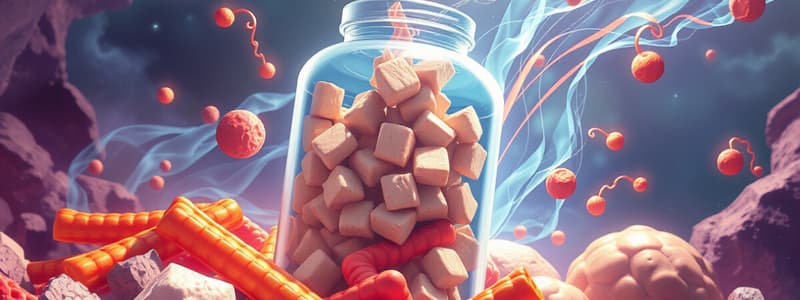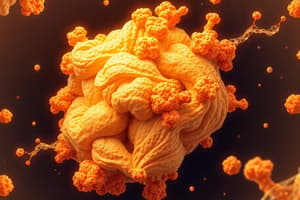Podcast
Questions and Answers
Proteins are:
Proteins are:
- Exclusively for muscle building and repair
- Large complex molecules found in the cells of all living things (correct)
- Stored in abundance, so dietary protein is required daily
- None of the above
What is one key difference between proteins and the other macronutrients?
What is one key difference between proteins and the other macronutrients?
- Protein structure is determined by DNA (correct)
- Proteins are larger molecules than fats and carbohydrates
- Protein is the only essential macronutrient
- Protein's calorie value per gram
Amino acids are molecules composed of a central carbon atom connected to four other groups: an acid group, a hydrogen atom, a side chain, and a(n) ________ group.
Amino acids are molecules composed of a central carbon atom connected to four other groups: an acid group, a hydrogen atom, a side chain, and a(n) ________ group.
amine
What is unique about an essential amino acid?
What is unique about an essential amino acid?
The portion of the amino acid that changes to give each amino acid its unique identity is the:
The portion of the amino acid that changes to give each amino acid its unique identity is the:
A peptide bond is when:
A peptide bond is when:
Gene expression refers to the process of:
Gene expression refers to the process of:
The DNA for making every protein in our bodies is contained in every cell's nucleus.
The DNA for making every protein in our bodies is contained in every cell's nucleus.
The term oligopeptide is used to identify a string of how many amino acids?
The term oligopeptide is used to identify a string of how many amino acids?
Which level of a protein's structure determines its function in the body?
Which level of a protein's structure determines its function in the body?
To protect the proteins in our body tissues make sure:
To protect the proteins in our body tissues make sure:
The functions of proteins do NOT include:
The functions of proteins do NOT include:
What kind of proteins are found within the cell membrane that assist in fluid balance?
What kind of proteins are found within the cell membrane that assist in fluid balance?
During digestion, where are proteins broken apart by hydrochloric acid?
During digestion, where are proteins broken apart by hydrochloric acid?
What are the enzymes that digest proteins in the small intestine?
What are the enzymes that digest proteins in the small intestine?
The RDA for protein for sedentary people is:
The RDA for protein for sedentary people is:
What is the recommended percentage of total energy intake that should come from protein?
What is the recommended percentage of total energy intake that should come from protein?
A high protein intake can be harmful because it can:
A high protein intake can be harmful because it can:
We can absorb more than 90% of the amino acids in soy protein sources.
We can absorb more than 90% of the amino acids in soy protein sources.
A highly specialized procedure referred to as ________ is used to determine a person's protein needs.
A highly specialized procedure referred to as ________ is used to determine a person's protein needs.
A semivegetarian is someone who:
A semivegetarian is someone who:
The most common reasons for being vegetarian include:
The most common reasons for being vegetarian include:
What is the main nutritional concern associated with a vegan diet?
What is the main nutritional concern associated with a vegan diet?
Study Notes
Proteins Overview
- Proteins are large complex molecules present in all living cells, not exclusively for muscle building and repair.
- Dietary protein is essential as the body does not store it; regular intake is necessary.
Key Differences with Other Macronutrients
- Protein structure is directed by DNA, distinguishing it from other macronutrients.
Amino Acids Composition
- Amino acids consist of a central carbon atom attached to four groups: an acid group, a hydrogen atom, a side chain, and an amine group.
- The side chain provides unique identity to each amino acid.
Essential Amino Acids
- Essential amino acids must be obtained from the diet to meet physiological needs and are not produced by the body.
Peptide Bonds
- Peptide bonds are formed when two amino acids join together.
Gene Expression and Protein Synthesis
- Gene expression entails using a gene to create a protein, facilitated within the cell's nucleus.
Oligopeptide Definition
- An oligopeptide consists of a chain of four to nine amino acids.
Protein Structure Levels
- The tertiary structure of a protein is crucial in determining its function within the body.
Protein Requirements
- Adequate calories from carbohydrates and fats are essential to protect proteins in body tissues.
- The recommended dietary allowance (RDA) for protein in sedentary adults is 0.8 grams per kilogram of body weight.
- Total energy intake recommendations suggest that 10-35% should come from protein.
Risks of High Protein Intake
- High protein consumption can increase the risk of heart disease without providing significant satiety.
Amino Acid Absorption
- More than 90% of amino acids from soy protein sources can be absorbed.
Protein Needs Assessment
- Nitrogen balance is a specialized method used to determine individual protein needs.
Vegetarian Diets
- Semivegetarians limit red meat consumption but may still eat other animal products.
- Common motivations for vegetarianism include ecological, ethical, and health considerations.
Vegan Diet Concerns
- Vegans may face nutritional concerns related to deficiencies in calcium, iron, zinc, vitamin B12, and vitamin D due to exclusion of animal products.
Studying That Suits You
Use AI to generate personalized quizzes and flashcards to suit your learning preferences.
Description
Test your knowledge on proteins and their functions with these flashcards from Chapter 6 of HUN 201. This quiz covers key concepts such as the structure, types, and dietary importance of proteins. Perfect for midterm review!




